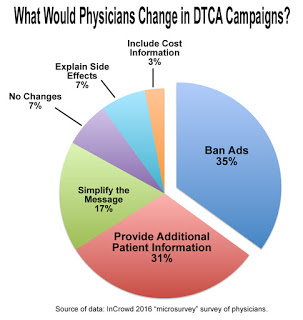 Results from a new “microsurvey” (N = 319) performed by InCrowd, a provider of real-time market intelligence to the life sciences and healthcare firms, reveal “perhaps surprising” U.S. healthcare provider (HCP) perceptions on the efficacy of direct-to-consumer (DTC) ads. Specifically, HCPs say DTC drug ads drove patients to asks three times as many questions today than they did 5 years ago, but 87% observed patient confusion with ads.
Results from a new “microsurvey” (N = 319) performed by InCrowd, a provider of real-time market intelligence to the life sciences and healthcare firms, reveal “perhaps surprising” U.S. healthcare provider (HCP) perceptions on the efficacy of direct-to-consumer (DTC) ads. Specifically, HCPs say DTC drug ads drove patients to asks three times as many questions today than they did 5 years ago, but 87% observed patient confusion with ads.
This sounds impressive, but looking at the data, HCPs say they receive only 6 questions about DTC drug ads per week from patients vs. 2 times per week 5 years ago. It just may be that HCPs are more aware of DTC ads today than they were 5 years ago and that is influencing their perception of the number of questions they receive from patients specifically about these ads.
The “confusion” results are more interesting.
A majority of HCPs surveyed (65%) said that patients do not generally understand the information provided by the pharmaceutical companies in advertisements, and nearly 87% of HCPs observed some level of confusion with the ads. 43% said that “some of my patients” can understand or interpret them, 41% said that “few” patients understand the ads, and 3% said that “none of my patients” can understand the ads.
The increased physician awareness of DTC ads and the patient confusion that they cause may explain why 35% of physicians surveyed said DTC ads should be banned when asked what they would do to change pharma’s DTC campaigns. 31% said the ads should provide additional information, and 17% said they should “simplify” the message. Only a paltry 3% said they would include cost information (see chart).
That only 7% of HCPs said they would like to see side effects explained is surprising considering the results of another survey.
InCrowd conducted this microsurvey over several months, beginning on June 15, 2016, which included 319 US physician respondents from a variety of specialties. Respondents possess an average of 18 years in practice, are an average age of 48 years old, and included 31% women and 67% men.








![6 Digital Tools at the Center of Healthcare Digitalization [INFOGRAPHIC]](http://ec2-54-175-84-28.compute-1.amazonaws.com/pharma-mkting.com/wp-content/uploads/2021/04/6DigitalTools_600px-100x70.jpg)




